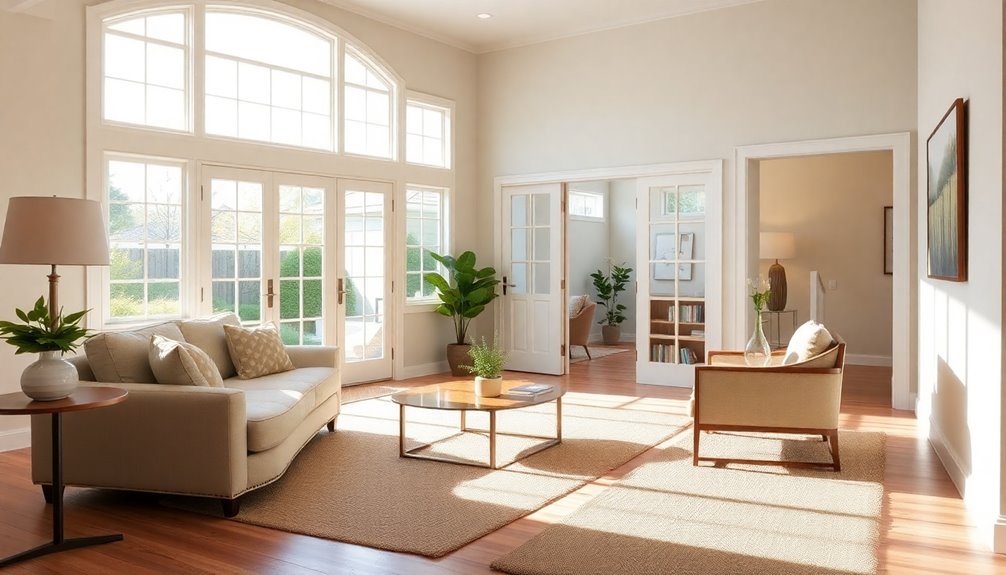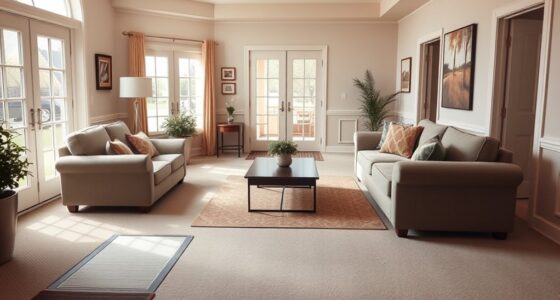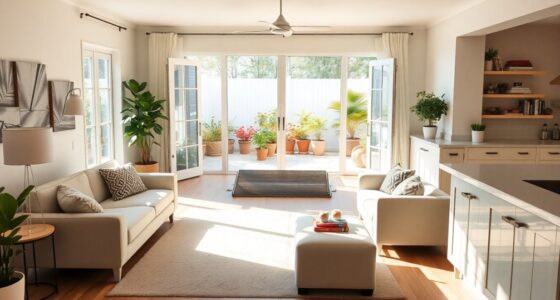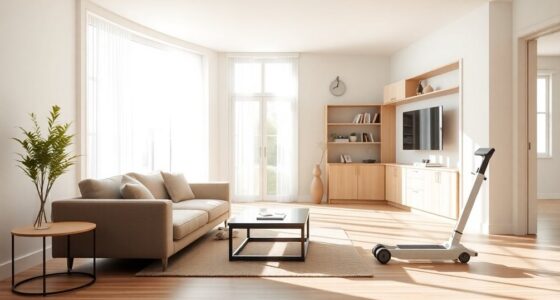If you want an accessible home, consider limiting stairs and obstacles for easy navigation. Embrace smart home technology for safety and convenience. Create spaces that bring the outdoors in, while maximizing natural light for a welcoming atmosphere. Upgrade your showers with multiple heads to enhance comfort. Don't forget about safety details like slip-resistant flooring and organized storage. Discover more innovative design secrets to transform your home into a safe haven for everyone.
Key Takeaways
- Incorporate ramps instead of stairs to enhance wheelchair accessibility and ensure smooth navigation throughout the home.
- Utilize smart home technology like voice control and smart locks to improve safety and convenience for all users.
- Design bathrooms with multiple shower heads and separate valve controls for easier access and comfort during personal hygiene routines.
- Maximize natural light with large windows and skylights, creating a bright and inviting atmosphere while reducing energy costs.
- Choose slip-resistant flooring and organize kitchen layouts to ensure safety and easy maneuverability for individuals with mobility challenges.
Limit Stairs and Accessibility Obstacles
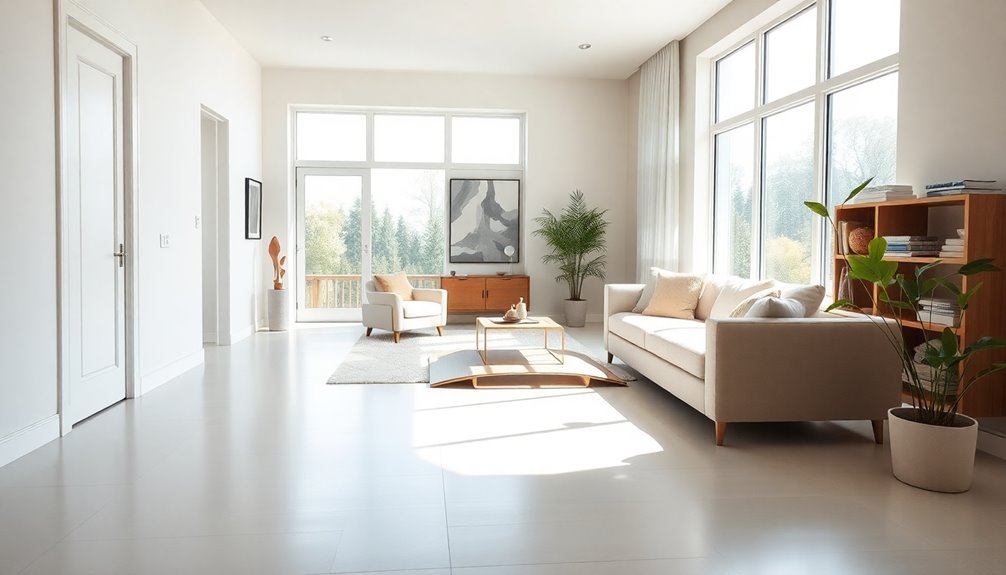
When you're designing an accessible home, limiting stairs and obstacles is essential for ensuring everyone can move freely.
Avoid homes with stairs, split levels, or raised entrances, as these can create significant barriers for individuals with mobility challenges.
Prioritize ramps over stairs for wheelchair accessibility, but keep in mind that existing homes may not always accommodate such changes easily.
A clear line of sight from the front door to the street enhances visibility and safety, so opt for low plantings and trimmed trees.
Make sure hallways and aisles are at least 42 to 48 inches wide to accommodate mobility devices effectively.
Incorporate universal design features like pocket doors or swing-clear hinges, ensuring doorways have a minimum width of 32 inches for ease of movement.
Use Smart Home Technology to Stay Safe
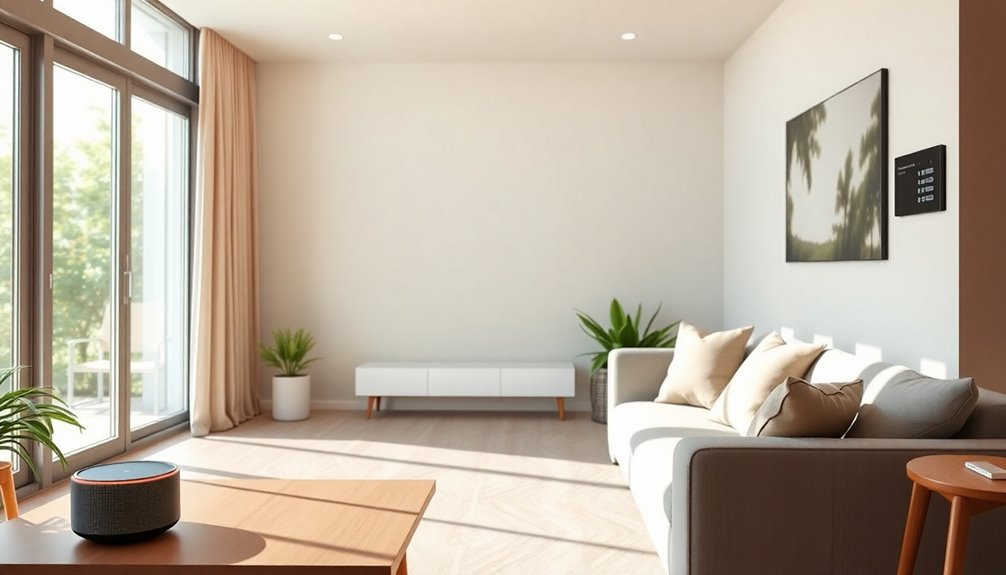
Smart home technology can greatly enhance your safety and convenience.
With voice-controlled home automation, you can easily manage your environment without moving around too much.
Plus, smart security features like video doorbells and locks give you peace of mind, allowing you to stay connected and secure from anywhere in your home. Additionally, incorporating energy-saving features can improve your home's efficiency while ensuring optimal comfort.
Voice-Controlled Home Automation
Home automation has transformed how we interact with our living spaces, especially for those facing mobility challenges.
With voice-controlled home automation, you can operate lights, thermostats, and appliances using simple commands, making your environment more accessible.
Smart home technology allows you to control smart locks remotely or via voice, enhancing security without fumbling for keys.
You can even integrate voice-activated systems with video doorbells, enabling you to screen visitors from anywhere in your home.
Programmable automation features can turn lights off when you leave and turn them on when you arrive, reducing navigation challenges.
Consulting a universal design specialist can help you maximize these technologies for an accessible design that truly fits your needs. Additionally, incorporating waterproofing treatments can protect electronic systems from moisture damage in areas prone to humidity.
Smart Security Features
Integrating smart security features into your living space not only enhances convenience but also boosts safety, particularly for individuals with mobility challenges. With smart locks, you can grant access to visitors remotely, eliminating the need to physically open the door. Video doorbells let you see who's at your door before granting access, ensuring peace of mind. Automated lighting systems can help prevent accidents by illuminating your path when you enter or exit your home. Additionally, motion-sensing lights improve visibility around your property. Furthermore, implementing these smart technologies can be crucial in mitigating risks associated with cybersecurity vulnerabilities that may arise from outdated systems.
| Feature | Benefits | Accessibility |
|---|---|---|
| Smart Locks | Remote access control | No need to physically gain entry |
| Video Doorbells | Visual screening of visitors | See who's at the door |
| Automated Lighting | Lights turn on/off automatically | Reduces falls in dark spaces |
| Motion-Sensing Lights | Activates when someone approaches | Enhances safety around home |
Bring the Outdoors Indoors Safely
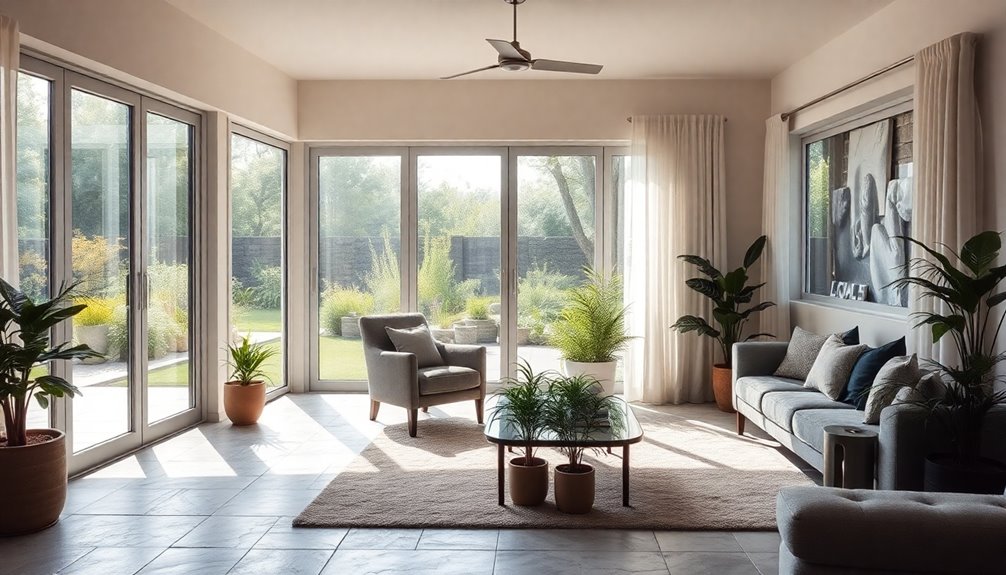
Bringing the outdoors indoors not only enhances your home's beauty but also boosts your well-being.
Consider installing French doors to create open passages and letting in natural light with large windows.
Using earthy materials and decor adds warmth and a calming atmosphere, making your space feel connected to nature. Additionally, incorporating eco-friendly initiatives can further improve your home's sustainability and connection to the environment.
French Doors for Views
French doors can transform your living space by seamlessly connecting the indoors with the beauty of your outdoor surroundings. With large glass panels, they provide unobstructed views and easy access to your backyard. Here's how they enhance accessibility:
| Feature | Benefits | Considerations |
|---|---|---|
| Wide Opening | Accommodates mobility devices | Confirm the space is clear |
| Low Threshold | Safe entry and exit for all users | Choose durable materials |
| Natural Light | Brightens the interior | Consider energy-efficient glass |
| Design Flexibility | Customizable for your aesthetic needs | Match with your home's style |
Additionally, incorporating smart capabilities in your home design can enhance accessibility and convenience for all users.
Natural Light Enhancements
How can you create a brighter, more inviting home while ensuring accessibility? Start by installing large windows with low sills to flood your space with natural light while allowing those in wheelchairs to enjoy the views.
French doors can also enhance accessibility and bring a seamless connection to your backyard. Consider adding skylights to maximize sunlight exposure throughout the day.
Incorporating indoor plants not only boosts the ambiance but also promotes a calming atmosphere. Pair these elements with strategic window placements to further enhance the flow of natural light. Additionally, ensure that your home cinema setup includes color accuracy for an optimal viewing experience that complements the natural light.
Earthy Materials and Decor
Creating a harmonious home environment is easy when you incorporate earthy materials and decor that invite the outdoors inside.
Using natural materials like wood and stone in your living spaces creates a warm, inviting atmosphere that enhances aesthetic appeal. Large windows with low sills not only let in ample natural light but also offer stunning views of your backyard, fostering a connection with nature.
Embracing earthy tones and natural textures in your decor promotes a calming environment that benefits mental well-being. DIY Fire Pit Ideas can also enhance your outdoor space, providing a cozy spot to enjoy nature even more.
Don't forget indoor plants; they improve air quality and add vibrancy to your home.
To enhance this peaceful atmosphere, consider using white noise machines to mask external sounds, creating a tranquil, nature-inspired haven.
Maximize Natural Lighting

To enhance your home's ambiance and well-being, maximizing natural lighting is essential. Consider adding windows or skylights to considerably increase natural light, boosting your mood and productivity. Use daylighting systems to capture sunlight effectively, which can also cut energy costs. Light-colored walls and ceilings reflect sunlight, making spaces feel larger and more inviting.
Here's a quick visual guide to help you think about natural lighting:
| Feature | Benefits | Tips |
|---|---|---|
| Windows | Increases natural light | Opt for large windows |
| Skylights | Enhances daylighting | Position in sunlit areas |
| Light Colors | Reflects and brightens space | Choose whites and pastels |
Consider Multiple Shower Heads to Help With Limited Mobility

When you consider installing multiple shower heads, you're maximizing flexibility and comfort in your bathing routine.
With options like a rain shower, traditional head, and handheld unit, you can easily switch between them for a more enjoyable experience.
Plus, having all the controls within reach makes it safer and more accessible, ensuring you feel luxurious while maintaining your independence. Additionally, incorporating easy-to-install fixtures can enhance functionality and refresh the space cost-effectively.
Enhanced Shower Flexibility
How can you transform your shower into a space that truly meets your needs? By incorporating multiple shower heads, like a rain shower, traditional showerhead, and handheld option, you'll create enhanced flexibility in your shower area.
This design promotes accessibility for individuals with limited mobility, allowing them to bathe comfortably whether seated or standing.
Having separate valve controls for each shower head means you can easily adjust water flow and temperature without reaching or stretching.
Positioning all shower heads within easy reach guarantees that everyone can use them safely.
Plus, designing your shower area with ample space aids navigation for mobility devices, reducing slip and fall risks while making your bathing experience enjoyable and relaxing. Additionally, ensuring proper maintenance of your shower fixtures can prolong their lifespan and enhance overall functionality, creating a safer and more enjoyable bathing environment.
Easy Accessibility Features
Incorporating multiple shower heads can transform your bathing experience, especially if you or someone you care for has limited mobility. By installing a rain shower, traditional showerhead, and a handheld shower, you create easy accessibility features that cater to various needs.
Separate valve controls for each shower head let users adjust water flow comfortably while seated, promoting independence in personal hygiene. Ensuring all shower heads are easily reachable minimizes awkward movements, making bathing safer for those facing mobility challenges.
Additionally, designing the shower area with ample space allows for easier navigation, particularly for wheelchair users or those needing assistance. These thoughtful adjustments make everyday bathing not just accessible, but also enjoyable for everyone involved. Furthermore, incorporating non-toxic materials in your bathroom design ensures a safer environment, especially for children and those with sensitivities.
Comfort and Luxury
Many people underestimate the impact of a well-designed shower on comfort and luxury, especially for those with limited mobility.
Incorporating multiple shower heads can transform your bathing experience, making it both accessible and indulgent.
Consider these features to enhance your shower:
- Rain shower head for a soothing experience
- Handheld showerhead for easy maneuverability
- Separate valve controls for adjusting water flow while seated
- Reachable heights for all shower heads, accommodating wheelchair users
- Adjustable showerheads to suit varying mobility needs
Prioritizing comfort and accessibility not only promotes independence but also adds a touch of luxury to your daily routine.
Transform your shower into a space where you can feel pampered and secure.
Install a Curbless Shower for Safer Entry

When you install a curbless shower, you create a seamless entry that enhances safety and accessibility for everyone. This design eliminates barriers, making it easier for individuals using wheelchairs or those with limited mobility to navigate.
The gradual slope towards the drain helps manage water flow while ensuring a safe environment. Raising the bathroom floor to match the shower area reduces the risk of tripping, creating a smoother passage.
Plus, ample space around the shower is essential to accommodate mobility devices, preventing tight navigation. A curbless shower doesn't just prioritize accessibility; it can also be designed with luxury and comfort in mind, enhancing the overall aesthetic of your bathroom while meeting everyone's needs.
Remember the Safety Design Details
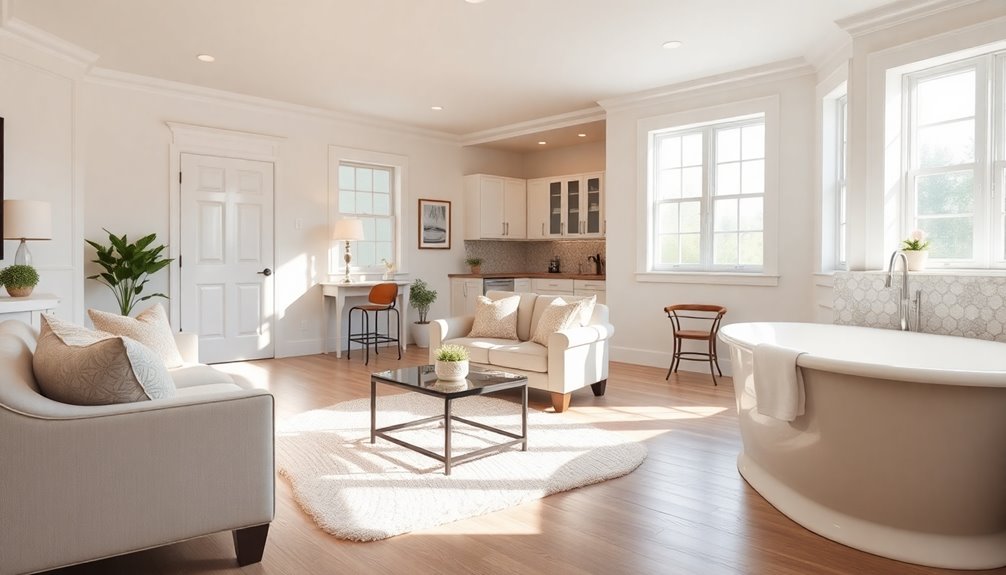
To create a truly accessible home, you can't overlook critical safety design details that make everyday tasks easier.
Focusing on these elements enhances safety and promotes independence:
- Place towel and robe hooks next to the shower for easy access.
- Include recessed storage in the shower for toiletries, reducing clutter and fall risks.
- Organize drawers to keep frequently used items within reach, minimizing clutter.
- Keep cords and hazards out of pathways to prevent tripping.
- Design storage solutions at accessible heights for convenience.
Pass the Closed-Fist Test for Accessibility
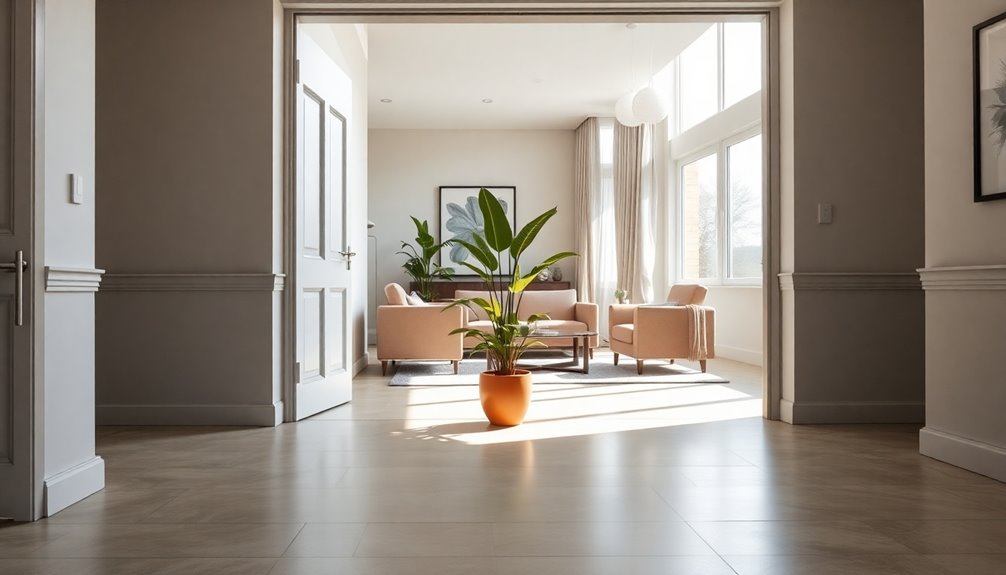
How can you guarantee that your home is truly accessible for everyone? One effective way is to pass the closed-fist test for accessibility. This means ensuring that faucets and door handles can be easily operated with a closed fist, catering to those with limited hand dexterity or strength.
Opt for lever-style door handles instead of round knobs, as they require less grip strength and can be operated with a forearm or elbow. Consider adding offset single-lever faucets or motion sensor faucets for hands-free use, making washing and cleaning tasks more convenient.
Don't forget accessible cabinet pulls, like D-shaped designs, which provide a better grip and easier access. Emphasizing accessibility in these areas can greatly enhance your home's usability.
Slip-Resistant and Comfortable Flooring to Avoid Falls
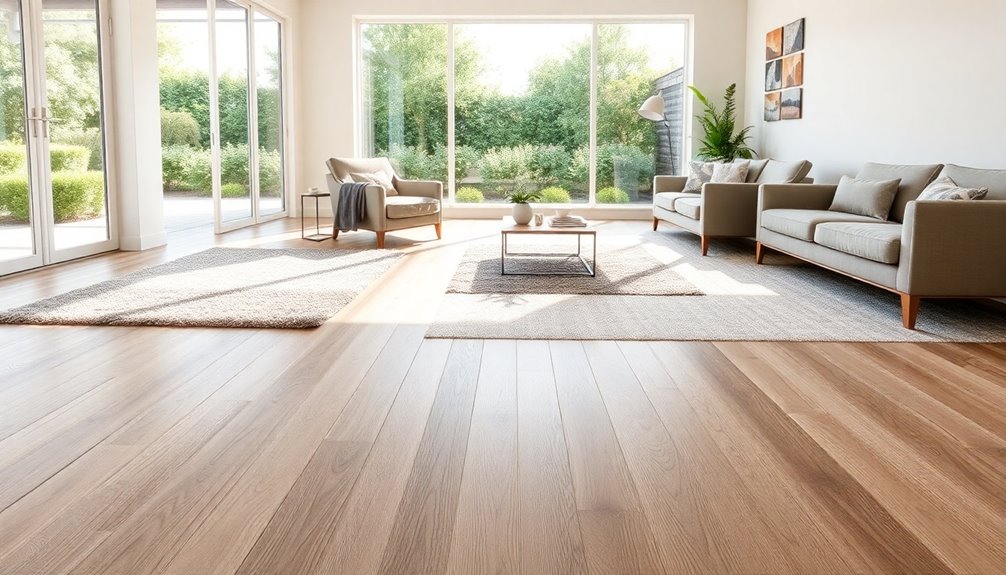
Creating a safe home environment means prioritizing slip-resistant and comfortable flooring to help prevent falls.
Choosing the right flooring can greatly enhance accessibility for everyone. Here are some tips to take into account:
- Apply non-slip treatments to existing tile and stone floors.
- Opt for smaller tiles to increase grout lines, enhancing traction.
- Use textured vinyl planks for comfort and safety in high-traffic areas.
- Think about nonslippery cork flooring for added cushioning and warmth.
- Verify all flooring materials are safe and accessible, especially for those with limited mobility.
Create Safer Work Areas in the Kitchen
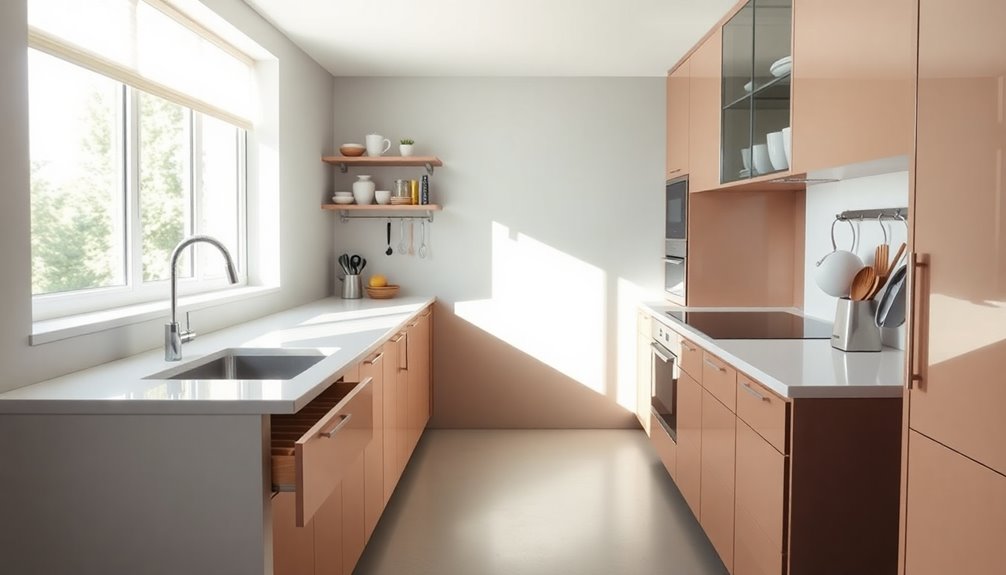
A well-designed kitchen can make all the difference for anyone who spends time cooking and preparing meals.
To create safer work areas, design your kitchen layout to keep the stove, sink, and fridge within close proximity, forming a universal work triangle that minimizes movement. Incorporate pull-out work surfaces at varying heights for both seated and standing users, enhancing accessibility.
Use lazy Susans and pull-out organizers in cabinets to simplify access to items, reducing the need for bending. Guarantee at least 30 inches by 48 inches of clear floor space in front of appliances to allow easy maneuverability for mobility devices.
Finally, implement rounded countertop edges and non-slip flooring to boost safety and prevent accidents in your kitchen space.
Frequently Asked Questions
What Is the Universal Design for Disabled People?
Universal design for disabled people focuses on creating spaces that everyone can access and use comfortably.
You'll find that this approach emphasizes features like wide doorways, lever-style handles, and curbless showers, making daily activities easier for individuals with various abilities.
Which of the Following Is an Example of Universal Design in a Home?
Imagine a home where every doorway's a welcoming embrace, wide enough for everyone to pass through with ease.
You'll appreciate lever-style door handles that invite you to open with a gentle push.
Picture a curbless shower, where stepping in feels like entering a serene oasis, free from barriers.
This home isn't just built; it's crafted for you, ensuring that every corner, every feature, enhances comfort and accessibility for all who dwell within.
What Are the 7 Principles of Universal Design With Examples?
The seven principles of universal design help create spaces that everyone can enjoy.
You'll find equitable use in single-lever faucets, which work for anyone.
Flexibility comes with adjustable countertops.
Simple and intuitive designs use visual icons on appliances.
Perceptible information involves contrasting colors for better visibility.
Tolerance for error minimizes risks, like non-slip flooring in bathrooms.
Finally, low physical effort guarantees ease of access, assuring all users can navigate your space comfortably.
What Is an Example of a Universal Design in Everyday Life?
One great example of universal design in everyday life is the lever-style door handle.
You'll find these handles are easy to use, even with a closed fist, making them accessible for anyone, especially those with limited hand mobility.
This simple design choice enhances usability for everyone, not just individuals with disabilities.
Conclusion
By embracing these universal design secrets, you're not just enhancing accessibility; you're creating a home that's safe, functional, and welcoming. You're limiting obstacles, maximizing comfort, and ensuring safety in every corner. You're blending style with practicality, inviting nature indoors, and harnessing smart technology for peace of mind. As you implement these strategies, you're crafting a space that truly supports your lifestyle—one that celebrates independence, fosters well-being, and makes every day easier and more enjoyable.
